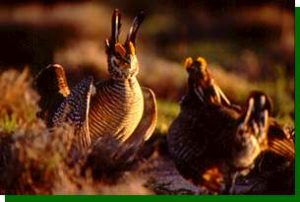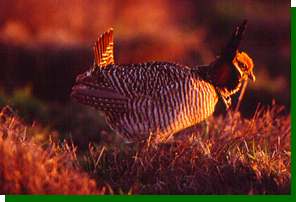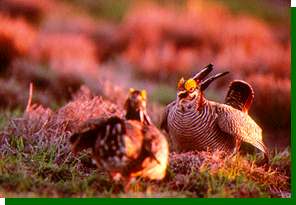
image (c) Joel Sartore www.joelsartore.com
In spring 1999, we began ambitious studies into the ecology and the causes of declines in Lesser Prairie-Chickens in Oklahoma and New Mexico. In 1995, the U. S. Fish and Wildlife Service (USFWS) was petitioned to list Lesser Prairie-Chickens as threatened under the Endangered Species Act.
Lesser Prairie-Chickens are found in southeastern Colorado, southwestern Kansas, northwestern Oklahoma, Eastern New Mexico, and the Texas Panhandle. Since the species occurs almost entirely on private lands in those states, the USFWS and state agencies have been working vigorously with private landowners to improve habitat conditions.
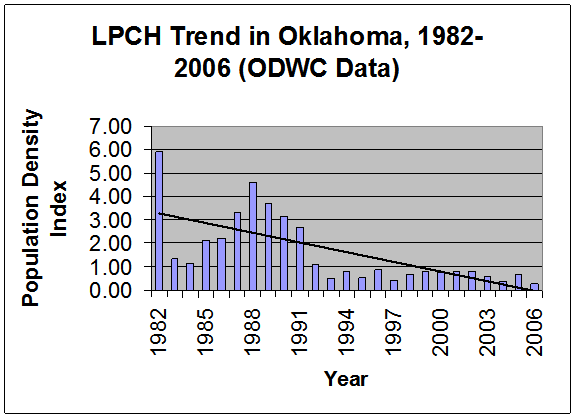 From April 1999 through February 2010, we captured and radio-tagged over 900 Lesser Prairie-Chickens in Oklahoma and New Mexico, recorded over 50,000 tracking locations, and located over 300 nests. Additionally, blood samples were taken from captured birds for disease and vitamin surveys, and for genetic analysis.
From April 1999 through February 2010, we captured and radio-tagged over 900 Lesser Prairie-Chickens in Oklahoma and New Mexico, recorded over 50,000 tracking locations, and located over 300 nests. Additionally, blood samples were taken from captured birds for disease and vitamin surveys, and for genetic analysis.
Our field research in New Mexico was completed in March of 2006, and a report is available on our publications page. Our tracking efforts ceased in February 2010 in Oklahoma, but we continue survey efforts, consultations, application of our results to management (for example, see section below regarding reducing mortality from collisions), and analyzing data.
One of the less pleasant tasks that are carried out by our field personnel was the recovery of carcasses and the determination of the cause of death. As of December 2004, we had determined cause of death from 260 carcasses; 91 (35.0%) were due to predation by raptors, 76 (29.2%) were due to predation by mammals, 86 (33.1%) were due to collisions with fences, 4 (1.5%) were due to collisions with power lines, and 3 (1.2%) were due to collisions with automobiles.
The charts presented below demonstrate the differences observed between study sites as well as between sexes. Note that collision rates are much higher for hens than for cocks. This is especially problematic in Oklahoma, where collisions (including power line and automobile collisions) account for over 57% of the hen mortality.
Mortality causes of Lesser Prairie-Chickens by sex and location
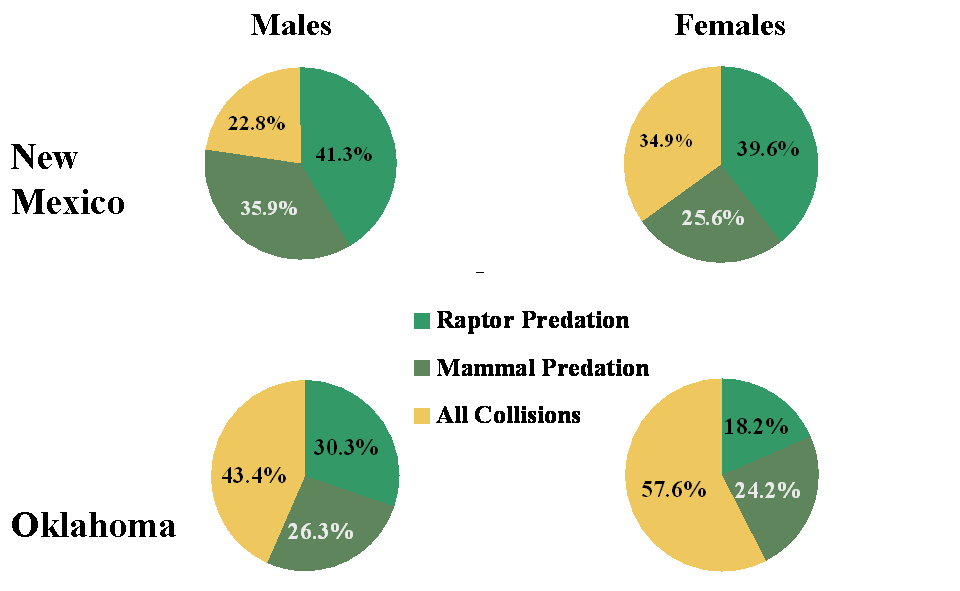
Kaplan-Meier survivorship estimates
| OK Males | OK Females | NM Males | NM Females | |
|---|---|---|---|---|
| One Year Survivorship | 0.622 | 0.506 | 0.539 | 0.663 |
| Two Year Survivorship | 0.310 | 0.138 | 0.313 | 0.416 |
| Predicted Two Year Survivorship* | 0.387 | 0.256 | 0.291 | 0.440 |
* Based on first year estimate
Since the initial data collected indicated that neither nest success (39%) nor adult survivorship (over 50% annual) could offer a complete explanation for declining populations, we sponsored a graduate student to research brood survivorship and microhabitat use in 2002 and 2003 at our New Mexico study site.
Vegetation data and microclimate data were collected for each brood location, and several random microclimate transects, with data loggers, were monitored. Young chicks received a 0.8-gram sew-on transmitter, and older chicks (30 days or more) received a 3-gram bib-mounted transmitter. The hens with broods selected warmer habitat during cool times and cooler habitat when it was warm. We also found that hens with broods preferred habitat with sand shinnery oak, not only to avoid high temperatures, but also when thermal refugia were not necessary. Areas treated with herbicide that kills sand shinnery oak were avoided, which suggest that shrub control may not be justified for Lesser Prairie-Chicken conservation. Additional details can be found in Bell (2005) and Bell et al. (2010).
Fence Marking: A conservation solution?
Our surprising finding that more than 40% of Lesser Prairie chicken mortality in Oklahoma is due to collisions with fences prompted a search for a means of reducing collisions. Removing old fences that are no longer needed is one obvious solution, and we are cooperating with landowners in high priority areas to help remove these fences.
Many fences, though, are needed by ranchers, and we began a long process of trial and error to find a durable, relatively easy to install, and relatively inexpensive method of marking fences to increase their visibility to prairie-chickens. Visit our fence marking instruction page to learn our method.
Publications
The list of publications resulting from our Lesser Prairie-Chicken research continues to grow. Below are the publications thus far (most are available for download at our publications page). Check back frequently for future results and publications.
- Winder, V. L., K. M. Carrlson, A. J. Gregory, C. A. Hagen, D. A. Haukos, D. C. Kesler, L C. Larsson, T. W. Matthews, L. B. McNew, M. A. Patten, J. C. Pitman, L. A. Powell, J. A. Smith, T. Thompson, D. H. Wolfe, and B. K. Sandercock. (2015) Factors affecting female space use in ten populations of prairie chickens. Ecosphere 6(9):166 (1-17). https://esajournals.onlinelibrary.wiley.com/doi/full/10.1890/ES14-00536.1
- Larsson LC, Pruett CL, Wolfe DH, and Patten MA. (2013) Fine-scale selection of habitat by the lesser prairie-chicken. Southwestern Naturalist 58(2):135-149.
- Dusang, D. E. 2011. Impacts of energy development on the Lesser Prairie-Chicken ecology and management. M. Sc. Thesis. University of Oklahoma. 66pp.
- Pruett CL, Johnson JA, Larsson LC, Wolfe DH, Patten MA (2011) Low effective population size and survivorship in a grassland grouse. Conservation Genetics 12:1205-1214.
- Hagan CA, Pitman JC, Sandercock BK, Wolfe DH, Robel RJ, Applegate RD, Oyler-McCance SJ (2010) Regional Variation in mtDNA of the Lesser Prairie-Chicken. Condor 112:29-37.
- Bell LA, Fuhlendorf SD, Patten MA, Wolfe DH, Sherrod SK (2010)Lesser Prairie-Chicken hen and brood habitat use on sand shinnery oak. Rangeland Ecology and Management 63:478-486.
- Bell LA, (2005) Habitat use and growth and development of juvenile Lesser Prairie-Chickens in southeastern New Mexico. MS Thesis. Okla. State Univ., Stillwater.
- Bell LA, Pitman JC, Patten MA, Wolfe DH, Sherrod SK, Fuhlendorf SD (2007) Juvenile Lesser Prairie-Chicken growth and development in southeast New Mexico. Wilson Journal of Ornithology 119:386-391
- Elmore D, Bidwell T, Ranft R, Wolfe D (2009) Habitat Evaluation Guide for the Lesser Prairie-Chicken. Publication E-1014 of the Oklahoma Cooperative Extension Service. Oklahoma State University, Stillwater.
- Horton, R., L. Bell, C. M. O’Meilia, M. McLachlan, C. Hise, D. Wolfe, D. Elmore and J.D. Strong. 2009. A spatially-based planning tool designed to reduce negative effects of development on the Lesser Prairie-Chicken (Tympanuchus pallidicinctus) in Oklahoma: A multi-entity collaboration to promote Lesser Prairie-Chicken voluntary habitat conservation and prioritized management actions. Oklahoma Department of Wildlife Conservation. Oklahoma City, Oklahoma. 79pp.
- Patten MA, Wolfe DH, Shochat E, Sherrod SK (2005) Effects of microhabitat and microclimate selection on adult survivorship of the Lesser Prairie-Chicken. Journal of Wildlife Management 69:1270-1278.
- Patten MA, Wolfe DH, Shochat E, Sherrod SK. (2005) Habitat fragmentation, rapid evolution, and population persistence. Evolutionary Ecology Research 7:235-249.
- Patten MA, Wolfe DH, and Sherrod SK (2006) The effects of shrub control and grazing on habitat quality and reproductive success of Lesser Prairie-Chickens. Final Report to New Mexico Dept. Game and Fish. 21pp.
- Patten MA, Wolfe DH, Shochat E, Sherrod SK (2005) Effects of microhabitat and microclimate selection on adult survivorship of the Lesser Prairie-Chicken. Journal of Wildlife Management 69:1270-1278.
- Patten MA, Wolfe DH, Shochat E, Sherrod SK. (2005) Habitat fragmentation, rapid evolution, and population persistence. Evolutionary Ecology Research 7:235-249.
- Pruett CL, Patten MA, Wolfe DH (2009) It’s not easy being green: Wind energy and a declining grassland bird. Bioscience 59:257-262.
- Pruett CL, Patten MA, Wolfe DH (2009) Avoidance behavior by prairie grouse: Implications for wind energy development. Conservation Biology. 23:1253-1259.
- Van Den Bussche RA, Hoofer SR, Wiedenfeld DA, Wolfe DH, Sherrod SK (2003) Genetic variation within and among fragmented populations of Lesser Prairie-Chickens (Tympanuchus pallidicinctus). Molecular Ecology 12:675-683.
- Wiedenfeld DA, Wolfe DH, Toepfer JE, Mechlin LM, Applegate RD, Sherrod SK (2002) Survey for reticuloendotheliosis viruses in wild populations of Greater and Lesser Prairie-Chickens. Wilson Bulletin 114:142-144.
- Wolfe DH, Patten MA, Sherrod SK (2003) Factors affecting nesting success and mortality of Lesser Prairie-Chickens in Oklahoma. Submitted to Oklahoma Department of Wildlife Conservation for Federal Aid in Wildlife Restoration Project W-146-R. 23 pp.
- Wolfe DH, Patten MA, Shochat E, Pruett CL, Sherrod SK (2007) Causes and patterns of mortality in lesser prairie-chickens Tympanuchus pallidicinctus and implications for management. Wildlife Biology 13 (Suppl. 1): 95-104.
- Grouse Bibliography compiled by Donald H. Wolfe (PDF file) More than 900 pages of grouse citations organized by genus.
- Article about fence collisions and Lesser Prairie-Chicken mortality from the Spring 2004 Sutton Newsletter (PDF file)
- Article about tracking Lesser Prairie-Chicken chicks from the Winter 2002 Sutton Newsletter (PDF file)
- More of our Lesser Prairie-Chicken and other publications
Older, hard to find Lesser Prairie-Chicken publications
- Copelin, F. F. 1963. The Lesser Prairie Chicken in Oklahoma. ODWC Tech. Bull. No. 6. 58 pp. PDF provided by the Sutton Center with the permission of the Oklahoma Department of Wildlife Conservation (PDF file size is more than 5 MB)
- Davison, V. E. 1935. The Davison Ranch, Ellis County Oklahoma, Game Bird Project. Unpublished report to Oklahoma Game and Fish Dept. 105 pp. PDF provided by the Sutton Center with the permission of the Oklahoma Department of Wildlife Conservation (PDF file size is more than 11 MB)
- Schwilling, M. D. 1955. A study of the Lesser Prairie-Chicken in Kansas. Kansas Forestry, Fish and Game Commission. PDF provided by the Sutton Center with the permission of the Kansas Department of Wildlife and Parks (PDF file size is more than 8 MB)
- Download an information and membership form for the North American Grouse Partnership in PDF format, which you can read and print using the free Adobe Acrobat Reader

